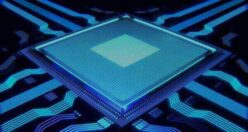The part that allows a computer to perform tasks in accordance with instructions given to us by various arithmetic and logical operators is called a processing device.
A microprocessor or CPU is a computer’s processing device. It is mounted on top of the motherboard in the system unit.
We can say, this is the heart of the computer. Like ordinary integrated circuits or ICs, microprocessors are also a type of IC, but a bit more complex. This complexity depends on the type of electronic circuit inside the microprocessor and the scale at which it is built. LSI stands for Large Scale Integration and VLSI stands for Very Large Scale Integration. Everything that is being made with today’s advanced technology is all in VLSI technology. Such as computer motherboard, different types of cards, mobile phone mainboard, remote control, etc.
A microprocessor can be further divided into three segments. These are (i) ALU or Arithmetic Logic Unit (ii) Register Array and (iii) CU or Control Unit
(i) Arithmetic Logic Unit: This part of the microprocessor is responsible for all types of arithmetic and logical operations. ALU performs these tasks with the help of various arithmetic and logical operators.
(ii) Register Array: Register array means where any information is temporarily stored. Registered by English capital letters B, C, D, E ………. etc. Array refers to different sectors.
(iii) Control Unit: The control unit is a very important part of the microprocessor. The function of this unit is to control the timing and signal required during any operation. With the help of the control unit, the computer can understand the difference between data and instructions. The CU also controls other devices on the computer while working.
Also Read – What Are the Functions of a Microprocessor?
A microprocessor is a programmable device. Inside are registers, flip-flops, and timing elements. When the microprocessor is made, its own number of instruction sets are created. All of these instruction sets help communicate with other hardware.
These instructions are stored in the processor memory. The microprocessor reads these instructions from memory and processes the data accordingly. After processing, the status of the data becomes a processed result. The microprocessor holds the processed result in memory or sends it to the output

